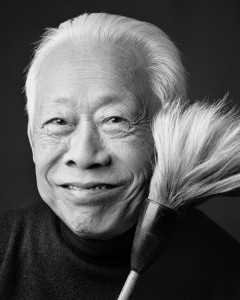Louise Joséphine Bourgeois (1911 – 2010) was a French-American artist. Although she is best known for her large-scale sculpture and installation art, Bourgeois was also a prolific painter and printmaker. She explored a variety of themes over the course of her long career including domesticity and the family, sexuality and the body, as well as death and the unconscious. These themes connect to events from her childhood which she considered to be a therapeutic process. Although Bourgeois exhibited with the Abstract Expressionists and her work has much in common with Surrealism and Feminist art, she was not formally affiliated with a particular artistic movement.
Born on December 25, 1911 in Paris, France, Bourgeois first studied mathematics at the Sorbonne before changing paths and enrolling in art school. She studied under Fernand Léger at the École des Beaux-Arts and later with Vaclav Vytlacil at the Art Students League of New York, having emigrated to the United States in 1938. Largely under appreciated during her early career, she garnered critical and public acclaim after her retrospective debuted at The Museum of Modern Art in New York in 1982. The artist died on May 31, 2010 in New York, NY at the age of 98 of a heart attack. Today, Bourgeois’s works are held in the collections of the Art Institute of Chicago, the Whitney Museum of American Art in New York, the Tate Gallery in London, and the Kunstmuseum Basel, among others.
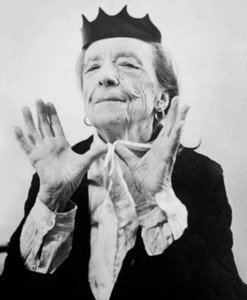
Georg Baselitz (b. 1938) is a renowned German painter and sculptor who is known for his nonconformist expression, which he developed amidst the East-West divide of a trauma ridden Post-War Germany. His work is visibly characterized by vibrant colors, evident brushstrokes, and the incorporation of the folkloric subject matter. Existentialism, ‘Art Brut’, and mental illness were major themes seen throughout his work. They were painted upside down, and displayed in the same way he painted them, in order to emphasize the madness he saw occur with his country’s atrocities in World War II. His provocative work and candidness on the behaviors of society have made him a polarizing art figure in the art world. Baselitz's works reside at museums such as the Guggenheim, the National Gallery of Art in Washington, D.C., The Museum of Modern Art in New York, the Tate Gallery in London, and the Berlinsche Galerie, among others.
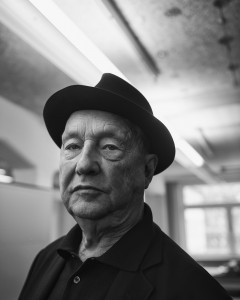
Jean-Michel Basquiat (1960 - 1988) took the world by storm as an artist, pop icon, cultural figure, graffiti artist, musician, and neo-expressionist painter in his short yet prolific career. A major influence in the creative outpour that was emerging in New York of the 1970s and ’80s, Basquiat was first known for his graffiti work in duo group SAMO (Same Old Shit). Ranging from spray painting and painting to drawings, Basquiat’s work had a wildly expressive nature that kept with his street art roots. His work encorporated text, multicultural symbols, history, and contemporary critique. His paintings were also a tool for self-analysis as well as a way to identify and comment on the experiences of the black community of his time. Basquiat's works reside at museums such as The Museum of Modern Art in New York, the Rubell Family Collection in Miami, and the Museum of Contemporary Art in Los Angeles, among others.

Georges Braque (1882 - 1963) is known as a key contributor in the fauvist movement as well as the co-founder of Cubism alongside Pablo Picasso. He was a French painter, collagist, and sculptor who revolutionized 20th-century painting. While Braque’s work is paralleled greatly with Picasso, Braque fragmented and reconstructed his geometric forms in his own way. During his experimentation with Cubism, Braque began to incorporate collage elements into his painting and became an innovator in the papier collé technique. After serving in World War I, Braque’s work became notably freer. After exhibiting in 1922 at the Salon d’Automne in Paris, his fame grew. Into the 1930s and 1940’s Braque reacted to the somber tone of World War II, continuing to work with painting, but also reaching out to other artistic formats such as printing, stained glass, and jewelry. While his work evolved, hints of cubism endured throughout. In 1933, he had his first retrospective at the Kunsthalle Basel, and in 1937 won first prize at the Carnegie International in Pittsburgh. He has since been shown at many notable institutions such as the Metropolitan Museum of Art in New York, The Museum of Modern Art in New York, and The Louvre in Paris. Braque’s works reside at museums such as Tate Gallery in London, The Museum of Modern Art in New York, the National Gallery of Art in Washington, D.C., and the Centre Georges Pompidou in Paris, among others.
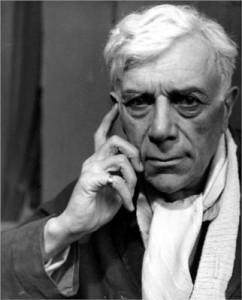
Daniel Buren (b. 1938) is a French conceptual painter whose work incorporates sculpture, installation, and painting. Buren is known for the development and implementation of “degree zero painting” in the 1960s, which is his approach to the conditions of making a work of art. His installation work uses lines and geometric shapes in reaction to the environment, transforming each site; throughout all of his work, simplified patterns, lines, colors, and alternating stripes highlight the architecture and space surrounding each piece. Buren’s works reside at museums such as the Musée d’Art Moderne de la Ville de Paris, the Tate Modern in London, The Museum of Modern Art in New York, and the Moderna Museet in Stockholm.

Alexander Calder (1898 - 1976) was an American artist best known for his large, colorful sculptures. Unlike anything seen before, Calder’s sculptures were made by bending and twisting wire to create three-dimensional “drawings in space”. Abstract shapes were boldly colored and hung in a graceful uncanny balance. These sculptures were later given the name “mobiles” by famed Dada artist, Marcel Duchamp, who was an admirer of Calder’s work. The complex assemblages Calder became so well known for were inspired by his interest in physics, astronomy, and kinetics, and playful demeanor. In a career that spanned seven decades, Calder created his mobiles as well as paintings, works on paper, standing sculpture, monumental outdoor sculptures, and jewelry. Calder’s works reside at museums such as The Museum of Modern Art in New York, the National Gallery of Art in Washington, D.C., the Whitney Museum of American Art, New York, the Art Institute of Chicago, and the Tate Gallery in London.
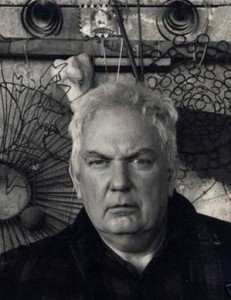
Marc Chagall (1887 - 1985) was a Belorussian-born French painter, printmaker, and designer whose work is noted for its vibrant emotional and poetic associations. Chagall’s dream-like imagery predated Surrealism and was among the first expressions of the potential of the unconscious mind in modern art. Chagall’s inspiration drew largely from Jewish culture and folklore in which he was immersed in as a Hasidic Jewish man. While his paintings may be his most well-known works, Chagall worked in various media including set design for ballets and plays, stain glass, illustration, and lithography. Chagall’s works reside at museums such as The Museum of Modern Art in New York, the Tate Gallery in London, the Tel Aviv Museum of Art, the Albertina in Vienna, and his piece America Windows is on permanent view at the Art Institute of Chicago.

George Condo (b. 1957) is a contemporary American artist known for his eccentric figurative paintings and prints. His unique visual language is often considered a tribute to paintings from the Old Masters with the allusion to contemporary American culture. Condo’s blending of art historical traditions with his fractured, unique, and somewhat aggressive characters leads his art to be wholly original. Condo has described his portraits as combinations of various psychological states that reflect the madness of everyday life. From his first public exhibitions in the East Village in the early 1980s to his 2011 retrospective exhibition “Mental States,” at the New Museum, Condo has been a key figure in the American painting scene for over 40 years. His work resides in museums such as The Museum of Modern Art in New York, the Rubell Family Collection in Miami, and the National Gallery of Art in Washington, D.C.

Salvador Dalí (1904 - 1989) was a Spanish painter and printmaker who was influential for his part in the Surrealist movement. His explorations of subconscious imagery within his paintings were groundbreaking at the time and are known to this day as the embodiment of Surrealism. Arguably one of his best-known works; Dali’s painting, The Persistence of Memory depicts melting clocks and ants in a vast landscape. This painting is a striking example of the strangeness of time, and shows Dalí’s desire to twist the viewers’ visual ideas about what is ‘normal’ and ‘accepted.’ The rise of fascist leader Francisco Franco in Spain led to the artist's departure from the Surrealist movement, although he still continued on with his artistic practices until his death in 1989. His works reside in museums and galleries around the world such as The Museum of Modern Art in New York, the Tate Modern in London, the Reina Sofia National Museum in Madrid, and the Museum Ludwig in Cologne.
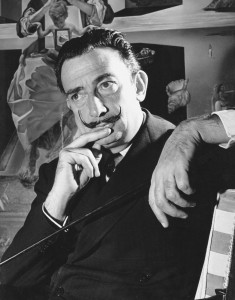
Jean Dubuffet (1901 - 1985) was a French painter and sculptor known for the development of the artistic movement ‘Art Brut’. ‘Art Brut’ or raw art, referred to the art of children, prisoners, and the mentally ill, and was a reaction to the academic tradition of fine art. To reflect the qualities of ‘Art Brt’, Dubuffet used childlike and obsessive mark-making and unorthodox materials such as sand, tar, and trash. His drawings and paintings have an unfinished appearance, which further reflects his desire to show creative possibilities beyond the conventions of the day. Not limited to painting and sculpture, Dubuffet continued to explore the potential of ‘Art Brut’ with his experimentation in musical composition and creating architectural environments. Dubuffet’s works reside in galleries and museums around the world such as the Art Institute of Chicago, The Museum of Modern Art in New York, the National Gallery of Art in Washington, D.C., and the Centre Georges Pompidou in Paris. He recently had a retrospective in 2019 in Venice called Jean Dubuffet & Venezia.
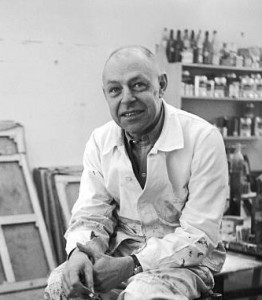
Lucio Fontana (1899 – 1968) was an Argentine-Italian painter, sculptor, and theorist who is known as the founder of Spatialism. The Spatialism movement focused on the synthesis of color, sound, space, movement, and time. Breaking through the two-dimensionality of the traditional spatial qualities of sculpture and painting, Fontana desired to create a new medium that blended architecture, painting, and sculpture. He was best known for his monochrome canvases known as Concetti Spaziale that he would cut or puncture, leaving distinctive gaping slash marks and holes which exposed the dimensional space beneath. Fontana’s innovative spatial theories heralded later developments in environmental art, performance art, and Avante-Garde art movements such as ‘arte povera’. Fontana’s first major international retrospective was held at the Solomon R. Guggenheim Museum in 1977. His works reside in museums and galleries around the world such as the Tate Gallery in London, the National Gallery of Art in Washington, D.C., the Kunstmuseum in Basel, and the Thyssen-Bornemisza Museum in Madrid.
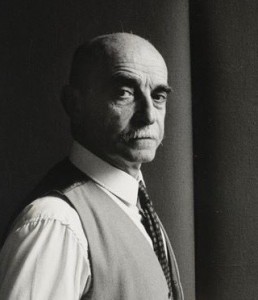
Helen Frankenthaler (1928–2011), whose career spanned six decades, has long been recognized as one of the great American artists of the twentieth century. A member of the second generation of postwar American abstract painters, she is widely credited with playing a pivotal role in the transition from Abstract Expressionism to Color Field painting. Through her invention of the soak-stain technique, she expanded the possibilities of abstraction, while at times referencing figuration and landscape in highly personal ways. She produced a body of work whose impact on contemporary art has been profound and continues to grow.
Frankenthaler became active in the New York School of the 1950s, initially influenced by artists like Arshile Gorky, Willem de Kooning, and Jackson Pollock, and as early as 1959 Frankenthaler began to be a regular presence in major international exhibitions. Throughout her long career, Frankenthaler experimented continuously. In addition to paintings on canvas and paper, she worked in a wide range of mediums, including ceramics, sculpture, tapestry, and especially printmaking. Hers was a significant voice in the mid-century “print renaissance” among American abstract artists, and she is particularly known for her woodcuts, in which she layered numerous colors in a manner that expanded the possibilities of the medium.

Keith Haring (1958 - 1990) was an American artist and social activist known for his pop art and graffiti inspired work. Haring moved to New York City in 1978 and began to use the city as his literal canvas. Along with artists Kenny Scharf and Jean-Michel Basquiet, Haring immersed himself in the punk clubs and street art scene. Haring’s popularity led him to create large outdoor murals in cities such as Paris, Rio de Janeiro, Berlin, Melbourne, Chicago, and Atlanta. As a socially conscious individual, the murals Haring created generally raised awareness and reflected his position on social issues such as AIDS and drug use. The energetic, social, and public nature of Haring’s work allowed his artistic reach to expand into music videos, fashion design, and even community outreach. Unfortunately Haring’s extraordinary career was cut short by his battle with AIDS. Many of Haring’s public murals can still be seen today, such as his mural Crack is Wack (1986) along FDR Drive in Manhattan. Haring’s works also reside in museums around the world such as The Museum of Modern Art in New York, the Los Angeles County Museum of Art, the Art Institute of Chicago, and the Smithsonian American Art Museum in Washington, D.C..
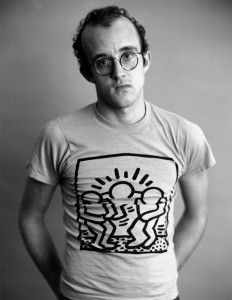
David Hockney (b.1937) is a British painter who is known for his revolutionized style of painting called ‘British Pop Art’. His artistic pursuits stretch across a vast range of media, from photographic collages, and full-scale opera stagings, to 21st-century technology-based work. Hockney gained notoriety with his semi-abstract paintings on the theme of homosexual love. In the painting We Two Boys Clinging Together, red-painted couples are shown embracing while floating amidst fragments from a Walt Whitman poem. After moving to California in 1963, Hockney began painting scenes of California life. Athletic men, swimming pools, palm trees, and sunshine were common in his work at this time. In the 1970s, Hockney began to experiment with photography and soon became famous for challenging the two-dimensionality of photography with his Polaroid grid photograph collages. His first solo show was in 1963 at the age of 26, and in 1970 the first of several major retrospectives was organized at Whitechapel Gallery, London. Hockney’s works reside in museums around the world such as the collections of The Museum of Modern Art in New York, the Centre Georges Pompidou in Paris, the J. Paul Getty Museum in Los Angeles, and the National Gallery of Victoria in Melbourne. Hockney had a recent retrospective at the Metropolitan Museum of Art in New York on display from 2017-2018.
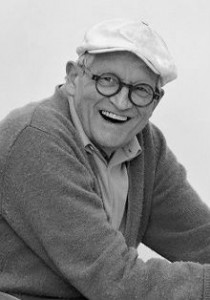
Alex Katz (b.1927) is an American painter recognized for his boldly simplified portraits and landscapes. Katz’s original use of wide strokes, bold colors, and flattening yet refined forms allows his work to lie between realism and abstraction. Katz's techniques, as well as his choice in uncomplicated displays of contemporary subjects, often associates him with the Pop Art movement. Katz began exhibiting work in 1954 and since then has produced acclaimed paintings, drawings, prints, and sculptures. His work resides in galleries and museums such as The Museum of Modern Art in New York, the Art Institute of Chicago, the Tate Modern in London, and the National Gallery in Washington, D.C. Katz has solo exhibitions on view at the Colby Museum of Art, Waterville, Maine, and at the Dallas Museum of Art, Dallas, Texas, until March of 2020.
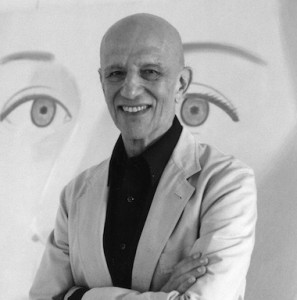
Yves Klein (1928 -1962) was a French conceptual artist best known for his blue monochrome paintings as well as his fearless approach to experimenting with new techniques of perceiving the real in art. Klein believed color embodied the essence of a pure idea and appears throughout his work. His initial monochrome efforts on canvas varied in color until 1957 with his show Proposition Monochrome; Blue Epoch. Klein’s use of blue in this show was monumental and resulted in him patenting his own signature hue known as IKB or International Klein Blue. Along with the monochrome series, Klein’s use of sponges, the human body, fire, and gold in his paintings further demonstrated his commitment to experimentation. The artist abruptly died from a heart attack at the age of 34. He left behind a body of work groundbreaking on its own but also for the later development of Minimalism and performance art. Klein’s work currently resides in museums and galleries around the world such as The Museum of Modern Art in New York, the Tate Gallery in London, the Centre Georges Pompidou in Paris, and the National Gallery in Washington, D.C. He has had many retrospective shows, including at the Musée Soulages, Rodez, France, and at the Power Station of Art, Shanghai, China, in 2019.

Avant-garde Japanese artist Yayoi Kusama (1929) was an influential figure in the postwar New York art scene, staging provocative happenings and exhibiting works such as her “Infinity Nets,” hallucinatory paintings of loops and dots (and physical representations of the idea of infinity). Narcissus Garden, an installation of hundreds of mirrored balls, earned Kusama notoriety at the 1966 Venice Biennale, where she attempted to sell the individual spheres to passersby. Kusama counted Donald Judd and Eva Hesse among her close friends, and is often considered an influence on Andy Warhol and a precursor to Pop art. Well known for her use of dense patterns of polka dots and nets, as well as her intense, large-scale environments, Yayoi Kusama works in a variety of media, including painting, drawing, sculpture, film, performance, and immersive installation. Born in Japan, Kusama came to the United States in 1957 and quickly found herself at the epicenter of the New York avant-garde. After achieving fame through groundbreaking exhibitions and art “happenings,” she returned to her native country in 1973 and is now one of Japan’s most prominent contemporary artists.
The nine decades of Yayoi Kusama's life have taken her from rural Japan to the New York art scene to contemporary Tokyo, in a career in which she has continuously innovated and re-invented her style. Well-known for her repeating dot patterns, her art encompasses an astonishing variety of media, including painting, drawing, sculpture, film, performance and immersive installation. It ranges from works on paper featuring intense semi-abstract imagery, to soft sculpture known as 'Accumulations', to her 'Infinity Net' paintings, made up of carefully repeated arcs of paint built up into large patterns. Since 1977 Kusama has lived voluntarily in a psychiatric institution, and much of her work has been marked with obsessiveness and a desire to escape from psychological trauma. In an attempt to share her experiences, she creates installations that immerse the viewer in her obsessive vision of endless dots and nets or infinitely mirrored space.
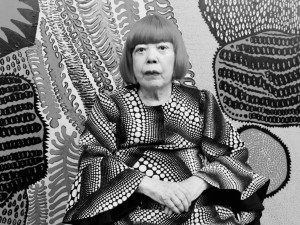
Fernand Léger (1881 - 1955) was a French painter who was known for his contribution to the Cubist movement. Léger had been painting in a style that mixed Impressionism with Fauvism prior to his move in 1908 to an art settlement in the Montparnasse area of Paris. Under the influence of his new environment and acquaintances that included Pablo Picasso and Georges Braque, he abandoned the Impressionist/Fauvist style for a more Cubist one. After serving in the military during World War I, Léger was deeply influenced by modern industrial technology. He developed “machine art,” which is a style characterized by boldly colored monumental mechanistic forms. Léger artistic pursuits did not stop at painting, starting in the 1920’s he experimented with other media. In 1926 he devised, directed, and produced The Mechanical Ballet, a non-narrative film with photography by Man Ray. He also designed sets for ballets and motion pictures, and he created mosaics and stained-glass windows. Léger’s work resides in museums worldwide, such as The Museum of Modern Art in New York, the Art Institute of Chicago, the Tate Gallery in London, the Centre Georges Pompidou in Paris, and the Albertina in Vienna.
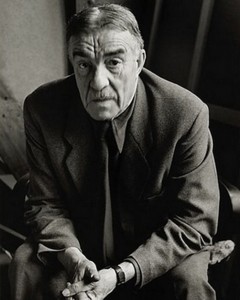
Sol Lewitt (1928 - 2007) was an American artist known for his conceptual art starting in the radical age of the 1960s. Sol Lewitt stressed the importance of the concept or idea of the work itself over the actual execution and is regarded by young generations of artists as one of the pioneering investigations into the conceptual art form. Lewitt is best known for his large wall drawings and structures. These large-scale works were created with an array of designs, geometric shapes, lines, and color rendered in pencil and paint. These works were created with strict instructions and diagrams in order to be followed and highlight his belief that the thought processes of the artist are sometimes more interesting than the final product. Lewitt created more than 1,200 works in his career and used a wide range of media along with painting and drawing including printmaking, photography, sculpture, and installation. While his work aligns considerably with minimalism, Lewitt rejected the connection to the movement. Lewitt’s has been the subject of numerous solo and group exhibitions and his work is held in collections worldwide, such as the Art Institute of Chicago, the National Gallery of Art in Washington, D.C., the Tate Gallery in London, the Dia Art Foundation in Beacon, NY, and the Walker Art Center in Minneapolis. In 2008, MASS MoCA opened Sol LeWitt: A Wall Drawing Retrospective, which will be on view through 2043, in a wing of the Museum specifically dedicated to his work.
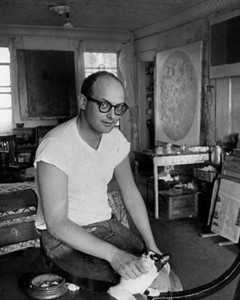
Roy Lichtenstein (1923 - 1997) was an American artist whose high-impact iconic paintings and prints have become synonymous with Pop Art. Lichtenstein’s work referenced commercial art and popular culture icons, and many were composed in a style mimicking the printing process of newspaper and comic strips. Lichtenstein used the printing technique of Ben-Day dots to show gradient and texture but created them by hand and on a much larger scale. His work defined the premise of pop art by making his compositions precise but also satirical. On his work, Lichtenstein has said “I take a cliché and try to organize its forms to make it monumental. The difference is often not great, but it is crucial”. There is no doubt that Lichtenstein’s artistry altered the history of Modern art and popular culture. In his career, Lichtenstein created over more than 5,000 works that range in the medium. Lichtenstein’s work resides in museums and galleries around the world such as the Art Institute of Chicago, The Museum of Modern Art in New York, the National Gallery of Art in Washington, D.C., and the Tate Modern in London.
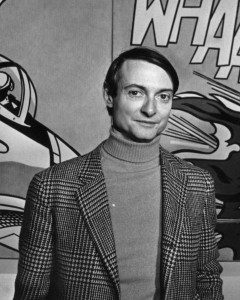
René Magritte (1898 - 1967) was a Belgian artist best known for his influential work in Surrealism. Magritte often painted ordinary objects in an unusual context and in effect gave new meaning to familiar things. The illusionistic images Magritte created challenged viewers’ preconceptions of reality in a witty way unseen before. His earliest work consisted of Impressionistic oil paintings, however after studying at the Academie Royale des Beaux-Arts in Brussels, he produced work inspired by Futurism and Cubism. Magritte focused on clearly depicting his subjects, in an illustrative style that intentionally avoided the stylistic distractions of modern painting. He also focused on repetition in his individual works, and in copying works, he had already made. This was perhaps influenced by his experience working as a commercial artist. Magritte’s work currently resides in museums and galleries worldwide, such as at the collections of The Museum of Modern Art in New York, the National Gallery of Art in Washington, D.C., the Musée Magritte Museum in Brussels, and the Tate Gallery in London.
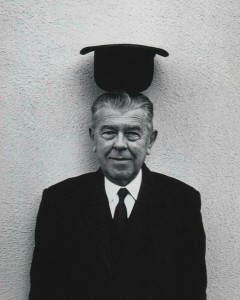
Georges Mathieu (1921 - 2012) was a French painter and theorist who played an important role in the Lyrical Abstraction and Informalism art movements in the 1940s and 1950s. Mathieu prioritized the primacy of speed, denial of references, and the ecstatic state in the creation of his paintings. His work had a distinct rhythmic and calligraphic quality which he created by using long brushes and applying paint directly onto the canvas from the tubes. The nature of Mathieu’s work led him to perform in public and on live television where he would create his quick paintings on camera. The rapid execution and movement to Mathieu’s paintings guaranteed uninhibited freedom unseen in other works of his time. Mathieu’s work has been the subject of numerous retrospectives and is in more than eighty museums and public permanent collections around the world such as the Solomon R. Guggenheim Museum in New York and the Art Institute of Chicago.
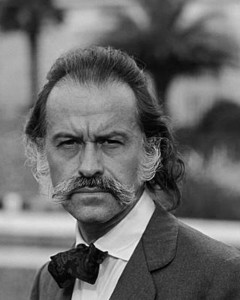
Roberto Matta (1911 - 2002) was a Chilean painter who is considered a defining figure in 20th-century Abstract Expressionist and Surrealist art. Matta was fascinated by the changing energies of the universe and rejected the notion of a single vantage point. Matta created multidimensional fantastical environments filled with crisis and agitated movement that aligned with the Surrealist’s philosophy of "automatic composition," which greatly influenced Abstract Expressionists’ study of ‘action painting’. After World War II, political activism occupied much of Matta’s time and he began including social critique into his work with figurative imagery. Matta’s work has had several hundred solo exhibitions and has work in museums and galleries such as the Tate Gallery in London, The Museum of Modern Art in New York, the Walker Art Center in Minneapolis, and the Peggy Guggenheim Collection in Venice.
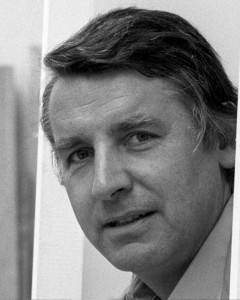
Henri Matisse (1869 - 1954) was one of the most influential artists of the 20th century. Celebrated for his use of unmodulated color, inventive figuration, and ornamental patterns, Matisse’s work redefined the formal principles of painting. Throughout his long career as a painter, sculptor, draftsman, and printmaker, Matisse was always striving to distill a form to its essentials. While he continually achieved this in what looked like an effortless manner, Matisse explained it was only an ‘apparent simplicity.’ He worked laboriously in achieving the balance, purity, and serenity encapsulated in his work. From ink drawings with flowing lines and dynamically colored paintings to innovative paper cut-outs, Matisse’s creativity extended across mediums all the while keeping to his ingenious forms and use of color. He has work in the permanent collections of many institutions, such as the Metropolitan Museum of Art in New York, the Museum of Modern Art in New York, and the Musée Matisse in Nice.
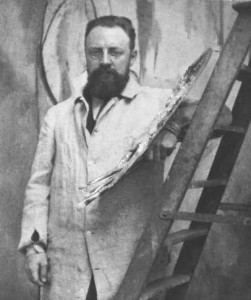
Joan Miró (1893 - 1983) was a Catalan Spanish artist known for his innovative use of line, organic shapes, and color. Although never officially part of the Surrealist movement, Miró is considered one of its leading figures and developed the linear style of Automatism - a technique of drawing haphazardly in order to show the inner workings of the human mind. Miró used color and form symbolically, and his intricate compositions combined abstract elements with motifs such as the moon, stars, eyes, and birds. In 1975, Fundació Joan Miró, a museum dedicated to his work was established. The foundation was conceived by Miró himself and was created partly to encourage young artists to experiment with contemporary art. Along with the Fudanció Joan Miró, Miró’s work resides in museums and galleries around the world such as the Art Institute of Chicago, The Museum of Modern Art in New York, and the Tate Gallery in London.

Joan Mitchell (1925-1992) was an abstract artist whose prolific career spanned more than four decades. She worked in a variety of mediums—including oil on canvas, pastel on paper, and lithographic printing—and is widely recognized as one of the most significant artists of the post-war era. Over her long and prolific career, the defining elements of Mitchell’s world—water, trees, dogs, poetry, music—created images and memories from which she worked. She once said, "I paint from remembered landscapes that I carry with me—and remembered feelings of them, which of course become transformed. I could certainly never mirror nature. I would like more to paint what it leaves me with." She observed her landscape intensely, and her acute visual observations of form, space, and color in life were part of the visual memories she drew upon while painting.

Claude Monet (1840 - 1926) was a French painter known for his leading role in the French Impressionist movement. Monet worked in the open air, documenting the change of natural light during different times of day, and employing this technique in his series of paintings. The first Impressionist exhibition in 1874, caused a stir in the public and art world, but in the following decades, public and critical opinion changed towards the style and gave Impressionists like Monet, the esteemed acknowledgment they deserved. Over the course of his prolific career, Monet produced more than 2,000 paintings with Impression, Sunrise, and his Water Lilies series being arguably his most famous. Monet's works are held in museums around the world such as the collections of the Hermitage Museum in St. Petersburg, the Musée d’Orsay in Paris, the National Gallery in London, The Museum of Modern Art in New York, and the Rijksmuseum in Amsterdam.
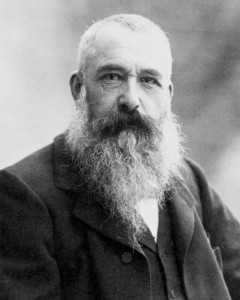
Henry Moore (1898 -1986) was an English sculptor and began his career as a teacher. With an early desire to become a sculptor, he attended the Leeds School of Art after serving in the military during World War I. He later became known as the foremost British sculptor of the 20th century. His most well-known work consists of cast bronzes with a figural human and animal focus, rendered as abstract and monumental with non-Western and “Primitive Art” influences, which he adapted into the Modernist style. Moore traveled throughout Europe, coming into contact with other avant-garde sculptors such as Barbara Hepworth, Georges Braque, and Alberto Giacometti. His work gained widespread notoriety, showing a retrospective at the Museum of Modern Art in New York in 1946, and winning the International Sculpture Prize at the 1948 Venice Bienniale. Some of his more recent retrospectives include shows at Tate Britain, the Maeght Foundation, and the National Gallery of Art. His work is in collections worldwide, including at the Hiroshima City Museum of Contemporary Art in Japan, the J. Paul Getty Museum in Los Angeles, and the Metropolitan Museum of Art in New York.
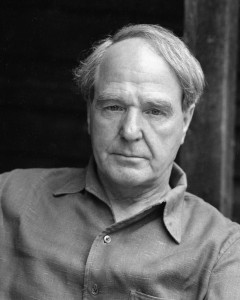
Pablo Picasso (1881 - 1973) was a prolific artist who worked with painting, drawing, collage, sculpture, and ceramics, and was one of the most influential artists of the 20th Century. Born in Málaga, Spain, and later moving to France, Picasso’s style was made up of his Blue Period (1901-1904), Rose Period (1905), Les Demoiselles d’Avignon (1907), and his Cubism phase (1908-1913) which was influenced by African Sculpture and the works of Cézanne. Starting as a young naturalist artist, his work matured throughout his life as he experimented with Cubism, Neoclassicism, Surrealism, and beyond, influencing modern and contemporary art throughout the decades. He is credited as one of the driving forces in having created the Cubist style, and often mixed styles to create entirely new ones. He also helped raise Collage to be recognized as fine art. Many artists after him are inspired by his use of color, form, and perspective. Picasso’s work is currently in the collections of many institutions, including the Museum of Modern Art in New York, The Musée Picasso Paris, Museu Picasso Barcelona, and the Metropolitan Museum of Art in New York.
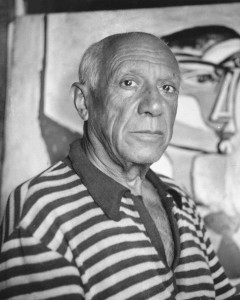
Camille Pissarro (1830 - 1903) was a Danish-French painter and printmaker viewed as one of the first impressionists and is known for using thick short brush strokes to render plein-air landscapes of farms, towns, and Parisian streets. He often focused on texture, tone, and high-keyed color in order to render the transient effects of light. Pissarro is the only artist to have shown in all eight of the Impressionist group Exhibitions. He began his exploration as an artist by making works of the West Indies, which he painted from memory and signed as ‘Pupil of A. Melbye,’ after his first instructor Anton Melbye. In France, he studied informally under Corot in 1855, which encouraged him to work from nature. Claude Monet and Paul Cézanne, who were his contemporaries, also influenced Pissarro. During the Franco-Prussian war, he fled to London, where he made pieces such as The Crystal Palace, London (1871). His works are currently in the collections of the National Gallery in London, the Musée d’Orsay in Paris, and the Metropolitan Museum of Art in New York.
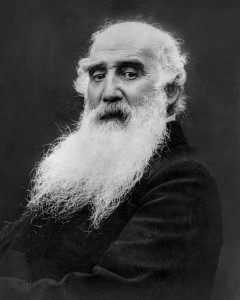
Robert Rauschenberg (1925 - 2008) was an American artist who is credited as the forerunner of nearly every Post-War movement since Abstract Expressionism. His work consists of a wide range of mediums, including mixed medium works, paintings, sculptures, prints, photography, and performance. Born in Port Arthur, Texas, he studied at a variety of art schools including the experimental Black Mountain College in North Carolina, where he studied under Josef Albers and was in contact with composer John Cage, the artist Cy Twombly, and the choreographer Merce Cunningham with whom he co-choreographed more than twenty dance pieces. In 1964, Rauschenberg won the Golden Lion at the Venice Biennale, which marks a significant turning point for the art world, in which the United States established itself as beyond the Old World art view, and introducing Pop Art into a contemporary canon. His work is in many collections such as that of the Museum of Modern Art in New York, the Guggenheim in New York, the Whitney Museum of American Art, and Tate Gallery London. He recently had a retrospective at the Museum of Modern Art in New York in 2017, titled Robert Rauschenberg: Among Friends.
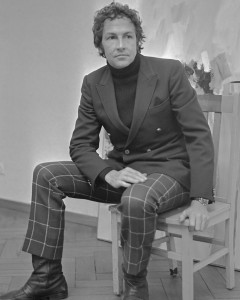
Pierre-Auguste Renoir (1841-1919) was a French painter who studied at the École des Beaux-Arts before meeting Claude Monet and Alfred Sisley, participating in first, second, third, and seventh Impressionist exhibitions of the 19th century. His early work is characterized as warm and colorful snapshots of real life. However, by the mid-1880’s he distanced himself from the impressionist movement by focusing on painting more structured compositions, inspired by the Renaissance artworks he saw while on a trip to Italy. His later work focuses on portraits, particularly of women. Even in his old age, he continued to paint although he suffered from arthritis, tying his paintbrushes to his wrists. He is most well known for making representational figurative and landscape paintings with lively brushstrokes. Renoir’s works reside at museums such as the Musée d’Orsay in Paris, The Museum of Modern Art in New York, the Hermitage Museum in St. Petersburg, and the National Gallery in London, among others.
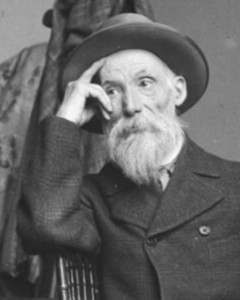
Bridget Riley (b. 1931) is a British artist known for making Op Art, optical pattern paintings. She is best known for her Op Art work she developed in the 1960s, using clean lines, color arrangements, and geometric precision in order to create mind-bending visual effects. However, her early work employed the semi-impressionistic style and began making pointillist landscapes in 1958. She currently lives and works in London, United Kingdom, and has work in the collections of The Museum of Modern Art in New York, the National Gallery of Art in Washington, D.C., the Tate Gallery in London, the Peggy Guggenheim Collection in Venice.
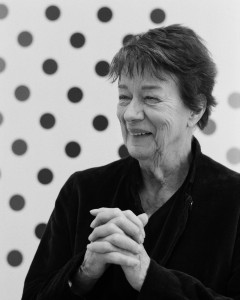
Jean-Paul Riopelle (1923 – 2002) was an Abstract Expressionist painter who gave Canadian artists an international platform in the arts. In the 1940s, Riopelle studied at the revered École des Beaux-Arts and the École de Meuble and was an apprentice to Paul Émile Borduas. In the 1950s, Riopelle coined “Abstract Landscapism” as a defining term to his surrealist-adjacent work. He soon fell into a relationship with fellow Abstract Expressionist, Joan Mitchell, who was an integral influence on Riopelle’s work until she passed in 1992 and Riopelle ceased painting. Riopelle’s work stood alone on an international stage and was admired for his unconventional ways of painting and creating abstract works. Riopelle died in 2002 with an impressive and extensive collection of works and a lasting impact on the art world. Riopelle’s works reside at museums such as the National Gallery of Canada, the Tate Gallery in London, the Art Institute of Chicago, and the Peggy Guggenheim Collection in Venice, among others.
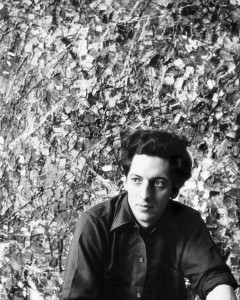
James Rosenquist (1933 -2017) was a renowned Pop artist of the 20th century, born in Grand Forks, North Dakota. Using popular brand imagery as the central theme of his work, his paintings and prints are a commentary on the American consumer. Rosenquist studied at the Minneapolis College of Art and Design (formerly the Minneapolis School of Art) and soon had the opportunity to join the Art Students League in New York City. During the1960s, the rise of Pop Art swept Rosenquist away from his abstract expressionist roots and focused on critiquing commercialism through popular iconography. Rosenquist’s background as a billboard painter also inspired his work and thematic choices. Rosenquist was a self-described “anti-pop” artist and his work reflects this anti-commercialist ideology. Rosenquist’s works reside at museums such as the Art Institute of Chicago, The Museum of Modern Art in New York, the National Gallery of Art in Washington, D.C., and the Tate Gallery in London.
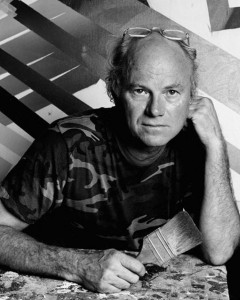
Ed Ruscha (b.1937) is a multidisciplinary artist blending Pop Art and Conceptual art to form unique works featuring the art of typography and text. Ruscha was born in 1937 in Omaha, Nebraska and after completing high school, he moved to Los Angeles to dive into the developing art scene. From 1956 to 1960, Ruscha studied at the California Institute of the Arts, formerly known as the Chouinard Art Institute. One of Ruscha’s biggest inspirations is the essence of Los Angeles and surrounding counties of Southern California, which remained one of the themes of his work until today. Using photography, painting, graphic design and countless other mediums, Ruscha became one of the influencers of the Conceptual art movement in the United States and inspired a generation of conceptual artists. His work is in many collections such as that of the Gagosian, the Getty, the Guggenheim and the Museum of Modern Art in New York.
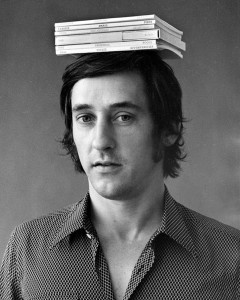
Alfred Sisley (1839 - 1899) was a French-born British painter renowned for his atmospheric and alluring landscapes that exemplify the Impressionist movement. In Paris during the 1860s, Sisley studied closely alongside Frédéric Bazille, Claude Monet, and Pierre-Auguste Renoir. These painters opted to paint outdoors rather than in a studio to fully observe and translate the fleeting effects of weather and light into their work. Unlike many of his peers who examined people, urban life, and industrialization, Sisley rarely strayed from painting landscapes. Sisley received little acclaim during his lifetime, but his dedication and sensitivity to the intricacies of natural landscapes would prove an impact on future landscape painters and categorize him amongst the great Impressionist artists. His work resides in museums and galleries worldwide such as the Art Institute of Chicago, the Musée d’Orsay in Paris, the National Gallery in London, and Neue Pinakothek in Munich.

Pierre Soulages (b.1919) is a French painter known for his involvement in the postwar Abstract Expressionist and Art Informel movements. From the 1940s to the 1970s, Soulages’ painting and printmaking work were characterized by thick black calligraphic brushstrokes against lighter backgrounds. Soulage's strong use of non-representational and calligraphic forms are said to have been influenced by East Asian calligraphy as well as prehistoric and Romanesque art near his childhood home in Rodez, France. The Outrenoir (Beyond Black) series of black monochromatic paintings beginning in 1979 were a pivotal endeavor for Soulages. The methodical layers of thick black paint were applied by scraping, digging, and so forth in order to evoke a smooth or rough surface on the canvas. The resulting texture of the paint either absorbed or rejected light and therefore disrupted the surface of the painting. As a result of Outrenoir, Soulage has become known as “the painter of black and light”. Soulages became the first contemporary artist to be shown at St. Petersburg’s Hermitage Museum in 2001. He donated 500 works to the Musée Soulages that opened in his hometown in 2014.
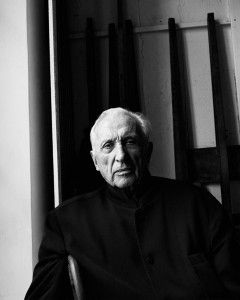
Frank Stella (b. 1936) is an American artist known for his impact on the Minimalist movement and evolution to a maximalist approach later in his career. Stella was creating art at the height of Abstract Expressionism but rejected the movement altogether. In the 1950s, Frank Stella gained immediate recognition for his use of repeated geometric shapes and lines. Stella was keen on exploring non-literary narratives in work and achieved this with his use of formal properties of shape, color, and composition. With Stella, the Renaissance concept of paintings being a window into a dimensional space was completely overturned. Stella continued working in his strict minimal style through the early 1960s but gradually began using brighter colors and more curvilinear shapes. In the 1970s, he moved away from the two-dimensional canvas and created compositions that projected out from the wall. He ultimately went on to create large freestanding sculptures. In 1970, Stella was the youngest artist ever given a solo exhibition at The Museum of Modern Art. His works currently reside in museums and galleries around the world such as the Metropolitan Museum of Art in New York, the Kunstmuseum Basel, the Art Institute of Chicago, the National Gallery of Art in Washington, D.C., and the Tate Gallery in London.
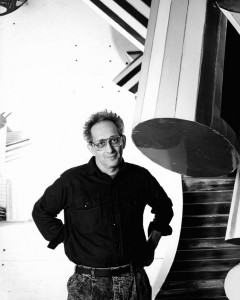
Maria Helena Vieira da Silva (1908 - 1992) was a Portuguese abstract painter known for her leading contributions to the Abstract Expressionist movement. In 1928, she moved to Paris and studied painting with Fernand Léger, sculpture with Antoine Bourdelle, and engraving with Stanley William Hayter. During this time in Paris, she became inspired by the works of Impressionist painter, Pierre Bonnard, and began to exhibit her own abstract paintings. Aside from a brief period in Lisbon and Brazil during World War II, Vieira da Silva resided in Paris for the rest of her life. Vieira da Silva is known for her dense and complex compositions with fragmented forms reminiscent of cityscapes. From 1970 until her death in 1992, Vieira da Silva shifted her artistic pursuits to tapestry work. A large number of her works are at the Árpád Szenes-Vieira da Silva Foundation.
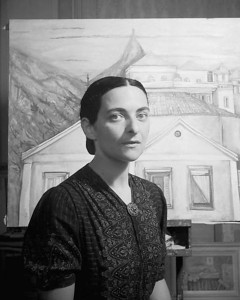
Andy Warhol (1928 - 1987) was an American artist, filmmaker, and cultural icon known for a leading role in the Pop Art movement of the 1960s. Warhol graduated from Carnegie Institute of Technology in 1949, and then moved to New York City and gained success as a commercial artist. In the late 1950’s he began painting and received sudden fame in 1962, with his paintings of Campbell’s soup cans, Coca-Cola bottles, and other consumer goods. Warhol pioneered the development of photographic silkscreen prints in the 1960s. The screenprinting technique enabled him to continue his series of purposefully cliched consumer goods but on a mass-produced scale. With the screenprint, Warhol notably started printing celebrity portraits as well. The repetition of garishly colored mass-media images ingeniously reflected the banality, emptiness, and ambiguity of American culture. In 1987, the artist died unexpectedly from routine gallbladder surgery at the age of 58. After his death, The Andy Warhol Foundation was created as well as a museum dedicated to the artist in his native Pittsburgh. Warhol’s work resides in museums and galleries around the world such as the Art Institute of Chicago, Museum of Modern Art in New York, and the Tate Gallery in London. Recently, a retrospective of his work was shown at the Whitney Museum in 2019.
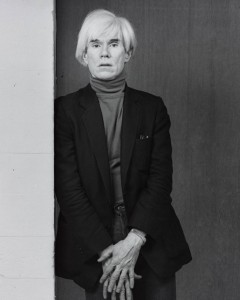
Tom Wesselmann (1931 - 2004) was one of the leading American Pop artists of the 1960s. He was best known for his collages, sculptures, and screenprints that explored still life, landscape, and classical portrayals of the nude female figure. His earliest works were small collages and assemblages, utilizing an array of found objects such as discarded paper, utensils, and even an old television. In 1961, his first large-scale series, Great American Nude earned him fame in the art world. His segmentation of the classical female nude to her mouth, nipples, and genitalia consequently reintroduced the ideal female form to art during the consumer age. Wesselmann's main interest with his work was not to draw attention to the subject, but to make figurative art as exciting as abstract art. He achieved this with the use of vivid and pure colors and the impersonal, advertisement-like motifs characteristic of the Pop Art movement. Wesselmann’s work resides in collections worldwide including The Museum of Modern Art in New York, the Tate Gallery in London, the Art Institute of Chicago and the National Gallery of Art in Washington, D.C.

Zao Wou-Ki (1921 - 2013) was born in Beijing, China. After attending the China Academy of Art in Hangzhou, Wou-Ki moved to Paris in 1947 to envelop himself in the abstraction movement of Europe. Combining both Chinese painting styles and Western abstraction, his work stood alone and was hastily entered into the Parisian art scene. With mentors like Joan Miró and Alberto Giacometti, Wao-Ki’s work was expressive, colorful and bold and began to incorporate more Chinese traditional painting techniques, such as calligraphy, into the 1950s. The network of abstract expressionist artists from across Europe and the United States allowed Wao-Ki to collaborate with other artists and inspired a multitude of different abstraction based projects. Wao-Ki’s sublime gesture work is obvious throughout his career, but his work took on a more dreamlike tone, creating luscious spaces and atmospheres during the 1970s. In 1994, Wao-Ki was the recipient of the Japanese Imperial Prize for painting and was a member of the Académie des Beaux-Arts. His work has been shown worldwide including at the Musée d’Art Moderne in Paris, the Marlborough Gallery in New York, the Macan Museum in Jakarta, Indonesia, and Levy Gorvy Gallery in New York. His works reside at museums such as the Tate Gallery in London, The Museum of Modern Art in New York, and the National Gallery of Art in Washington, D.C., among others.
